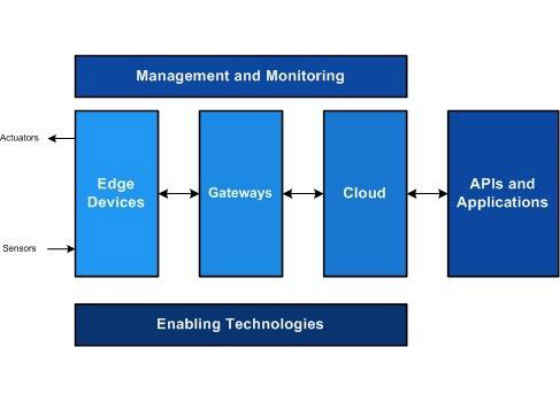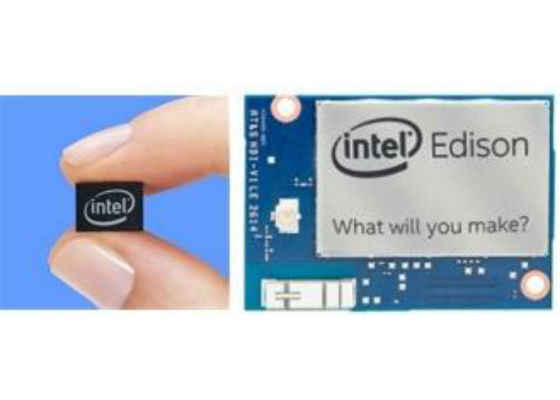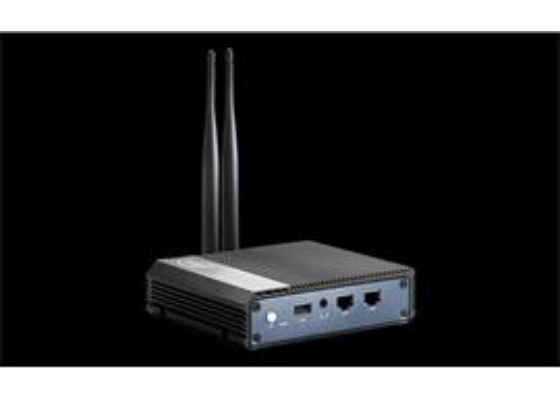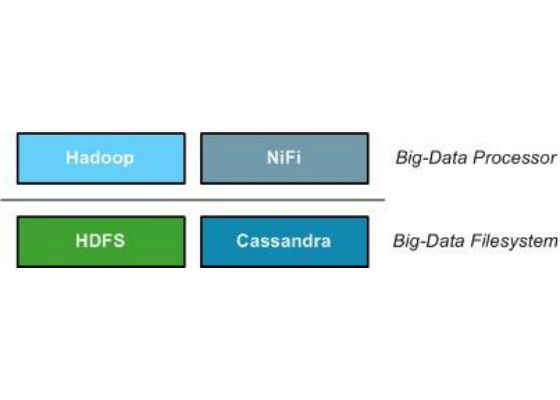Understanding the IoT Ecosystem
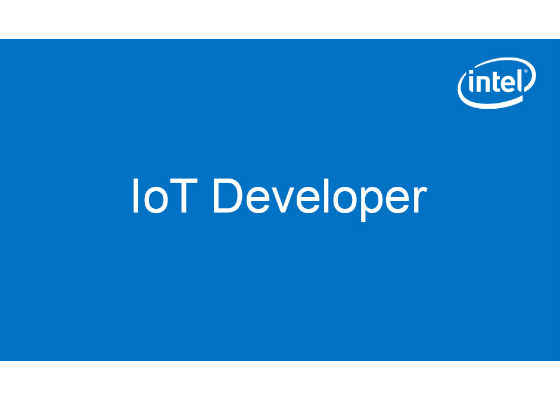
Anatomy of the IoT Ecosystem
Wearables and home automation devices dominate the IoT market today, but the overall ecosystem for the IoT will evolve. Figure 1 illustrates a simplified IoT ecosystem:
- At the left side are the edge devices. These are the IoT end points, and the provide the means to sense and control their environment through sensors and actuators.
- Gateways aggregate data from edge devices and present it to the cloud (while providing control from the cloud). In some cases, gateways may process data to add value into the ecosystem.
- The cloud provides the means to store data and perform analytics. The importance of a cloud is a set of resources that can scale up or down in an elastic fashion as a function of need.
- The cloud enables monetization of the data and control through application programming interfaces and apps (which may or may not reside in the cloud, as well).
- At the top is management and monitoring across all levels of the ecosystem.
- At the bottom are technologies that enable development, test, and other critical capabilities, such as end-to-end security (for the data and control planes).
Figure 1. Simplified Internet of Things Ecosystem
Now, let’s look at each part of the IoT ecosystem and which technologies are applied.
Edge
At the edge of the IoT ecosystem are connected devices that can sense and actuate at various levels of complexity. In the wearables space, you’ll find smart wristbands and watches that include biometric sensing. In the automotive space, you’ll find networks of smart devices that cooperatively create a safer and more enjoyable driving experience (through sensors that improve drivetrain efficiency or tune automotive parameters based on altitude or temperature).
In the space of power-conscious wearable devices, you’ll find processors like Intel® Quark™ SoC (in the tiny Intel® Curie™ Compute Module), which can operate from a coin-sized battery, and includes a six-axis combination sensor (accelerometer and gyroscope). For greater processing power, the Intel® Edison compute module supports both single-core and dual-core Intel® Atom™ CPUs. The Intel® Edison board can run Yocto Linux*, so the software ecosystem enabled there creates endless development opportunities (see Figure 2).
Figure 2. The Intel® Curie™ Computer Module and Intel® Edison board
Gateway
When we talk about the IoT, the emphasis is on things—lots of them. For this reason, the gateway is an integral part of the IoT ecosystem, bridging small edge devices that may include little intelligence to the cloud (where the data may be monetized). The gateway can serve one or two primary functions (sometimes both): It can be the bridge that migrates collected edge data to the cloud (and provides control from the cloud), and it can also be a data processor, reducing the mass of available data on its way to the cloud or making decisions immediately based on the data available. For this reason, gateways tend to be more powerful than the edge devices.
The Intel® IoT Gateway is a platform for development of IoT gateway apps (see Figure 3). What makes this a platform is the integration of key communication technologies (including Ethernet, Wi-Fi, Bluetooth*, and ZigBee*, as well as 2G, 3G, and Long-Term Evolution) and sensor/actuator interfaces (RS-232, analog/digital input/output), with processing capability from single-core Intel® Quark SoCs to dual-core and quad-core Intel® Atom™ and Intel® Core™ processors. To simplify development, the Intel IoT Gateway supports Wind River Linux* 7, Windows® 10, or the Snappy Ubuntu* Core (with integrated driver support for the various interfaces, allowing you to focus on your app).
Figure 3. The Intel® IoT Gateway Platform
You can simply development further by using the Wind River* Intelligent Device Platform XT. Intelligent Device Platform XT is a customizable middleware development environment that provides, among other things, security and management technologies. Although these features are commonly developed as an afterthought, bringing security and manageability in at the start enables a world-class IoT gateway that protects your data and minimizes downtime.
Cloud
Think of the cloud as an essential part of the IoT ecosystem, given its attributes of scaling and elasticity. As data grows from edge devices, the ability to scale the storage and networking assets as well as compute resources becomes a key enabler for the development of IoT systems.
What makes elastic compute possible is a technology called virtualization. Using virtualization, you can carve up a processor to represent two or more virtual processors. Each virtual processor time-shares the physical processor such that when one needs less computing power, another virtual processor (and the software that occupies it) can exploit those physical resources.
Virtualization has been around for some time, but you can find extensions in modern processors that make the technology more efficient. As you’d expect, you can find these virtualization extensions in powerful Intel® Xeon® processors for data centers, but you can also find them in lower-power Intel® Atom™ processors.
Virtualization means that when more IoT data flows from edge devices, physical processors can be carved up and associated with these data flows. When the flow of data subsides, these resources can be idled or reassigned to other tasks to save power and cost.
Management and Monitoring
A complexity that the IoT creates is the monitoring and management of gateways and edge-devices. Considering that an IoT system could contain thousands of gateways with many millions of sensor and actuator endpoints, management and monitoring present new challenges.
Although it’s possible to build a custom cloud-based set of apps to meet this challenge, you must also consider time-to-market constraints. This is one of the reasons Wind River created the Wind River Helix* Device Cloud. Device Cloud is a cloud-based IoT platform that provides device management, end-to-end security, and telemetry and analytics. Device Cloud is a technology stack that operates from the edge device into the cloud and offers data capture, data analysis, and overall monitoring and management for IoT systems at their scale. Device Cloud is also fully integrated with Intel® IoT Gateway Technology, as well as a portfolio of operating systems, such as Wind River Linux and VxWorks*.
Analytics
The key behind IoT is data, and this is where you create value. IoT data can come in many forms, but it commonly has two attributes: its scale and its relationship with time.
Realization of the IoT was partially enabled by big data processing systems. These systems were designed for datasets that require nontraditional processing methods. The datasets that massive numbers of edge devices create in an IoT ecosystem are a perfect match. The other aspect of IoT data is that it tends to be time-series data. Its storage and analysis are better suited to big data processing systems and NoSQL databases than traditional approaches.
Apache Hadoop* (such as provided through Cloudera) remains the key big-data processing system that includes an ecosystem in itself of technologies to address a range of needs. Apache NiFi*, for example, is a dataflow system that permits flow-based programming through directed graphs (perfect for streams of time-series data). Apache Cassandra*, which differs from the batch-oriented Hadoop Distributed File System (HDFS), is a NoSQL database distributed across nodes and supports clusters spanning geographically distributed data centers. The Cassandra data model is also ideal for real-time processing of time-series data (using a hybrid key-value and column-oriented database). Figure 4 illustrates these components’ relationships.
Figure 4. Relationship of big data processing systems and their file systems
Analytics is an ideal match for the cloud. The ability to scale compute resources as a function of dataset size or processing speed requirements makes the cloud a perfect platform for analyzing IoT data with systems like NiFi. Elastically expanding the compute capabilities for processing a dataset, and then gracefully decreasing those resources when no longer needed minimizes infrastructure cost.
Enabling Technologies
The IoT ecosystem is enabled by a collection of other technologies that are important to understand. Let’s focus on some of the technologies for development and test and a few technologies that live inside devices
within the IoT ecosystem:
- The Wind River Helix App Cloud is a browser-based development environment for IoT apps. Using App Cloud, you can develop code, build on top of Wind River operating systems, and simplify app testing using devices such as the Edison board. Because it’s a browser-based development environment, you can attach to your environment from anywhere with everything you’d expect from a world-class integrated development environment.
- Wind River Helix Lab Cloud, fully integrated with App Cloud, allows broad testing of apps over a range of virtualized devices. Using Lab Cloud, you can create a device configuration that represents a physical device, and then virtualize that device in the cloud. Using App Cloud, you can then load your code onto the device for validation. As a set of virtualized resources, you could create thousands of devices for testing, allowing you to find bugs more quickly. Lab Cloud helps you make reliable IoT apps at the edge device or gateway.
- Wind River Rocket* is a best-in-class real-time-operating-system (RTOS) designed for the IoT, using hardware such as the Intel® Edison™ board. Rocket was designed to be scalable, running on as little as 4 KB of memory for power and memory constrained systems. Rocket provides all the services you’d expect from an RTOS, including multithreading, and is preintegrated with App Cloud, making it simple to build gateway or edge device apps in minimal time.
- Wind River Pulsar* Linux is a Linux distribution for small, high-performance IoT systems that require security and manageability. Pulsar supports kernel reconfiguration so that you can tailor it to your needs and includes capabilities like virtualization to build complex IoT apps. You’ll also take advantage of continuous updates to ensure a reliable and secure platform. You can use Pulsar on a variety of hardware solutions, such as the MinnowBoard MAX* board, and Intel® Atom™ CPU.
For more such intel IoT resources and tools from Intel, please visit the Intel® Developer Zone
Source:https://software.intel.com/en-us/articles/understanding-the-iot-ecosystem

